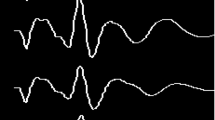Abstract
This paper studies the effect of otologic disease on the Brain Stem Auditory Evoked Response (BAER). Both conductive and neurosensory hearing losses are analyzed by plotting wave V latencies and amplitude as a function of sound intensity. It was found that BAER is elicited primarily by frequencies greater than 2000 Hz. Conductive hearing losses produce a latency-intensity function which approaches the norm with high decibel stimulation. Neurosensory losses produce a variety of latency intensity functions. In determining the degree of hearing loss, wave threshold is found to be the best index. Wave latency at high decibels is found to have little correspondence to degree of neurosensory loss ; wave amplitude is highly variable among subjects but still a useful indicator for detecting pathology.
Similar content being viewed by others
References
Berlin, C.I., Gondra M.I., Casey D.A.et al. (1978): Bone conduction electro-cochleography : Clinical applications.Laryngoscope 88 : 756–763.
Coats, A.L. (1978): Human auditory nerve action potentials and brain stem evoked responses.Arch. Otolaryngol. 104 : 709–717.
Coats, A.C., Martin, J.L. (1977): Human auditory nerve action potentials and brain stem evoked responses.Arch. Otolaryngol. 103 : 605–622.
Davis, H.; Hirsh, S.K. (1976): The audiometric utility of brain stem responses to low frequency sounds.Audiology 15 : 181–195.
Gupta, D. and Vishwakarma, S.K. (1989): Brain Stem Auditory Evoked Response - A Study in Parameters.Ind. J. Otolaryngology,41 : 6–8
Hecox, K. (1983): Development of auditory brain stem responses in Gerber and Menchen (Eds.) : The development of auditory behaviour. New York, Grune and Stratton Inc.
Hicks, G.E. (1980): ABR sensory assessment by bone conduction masking.Arch. Otolaryngol. 106 : 392–395.
Jergcr. J., Mauldin, L. (1978): Prediction of sensoryneural hearing level from the brain stem evoked responses.Arch. Otolaryngol. 104 : 456–461.
McGee, T.J., Clemis, J.D. (1982): Effects of conductive hearing loss on auditory brain stem response.Ann. Otol. Rhinol. Laryngol. 91 : 304–309.
Moller, A.R. (1974): Function of the middle ear, in Keidel, W.D., Nefl, W.D. (eds.) : Handbook of sensory physiology. Berlin, Springer Verlag. Vol. V/I, 494–498.
Picton, T.W., Woods, D.L., Baribeau-Braun, J.et al. (1977): Evoked potential audiometry.J. Otolaryngol. 6 : 90–118.
Selters, W.A., Brackman, D.E. (1977): Acoustic tumor detection with brain stem electric response audiometry.Arch. Otolaryngol. 103 : 181–187.
Starr, A., Achor, I.J. (1975): Auditory-brain stem responses in Neurological disease.Arch. Neurol. 32 : 761–768.
Von Bekesy, G. (1960): Experiments in hearing. New York, McGraw Hill.
Author information
Authors and Affiliations
Rights and permissions
About this article
Cite this article
Gupta, D., Vishwakarma, S.K. Brain stem auditory evoked response-evaluation of hearing loss. Indian J Otolaryngol 41, 54–58 (1989). https://doi.org/10.1007/BF02994355
Issue Date:
DOI: https://doi.org/10.1007/BF02994355



